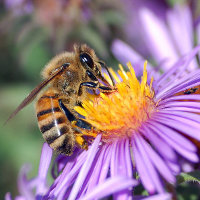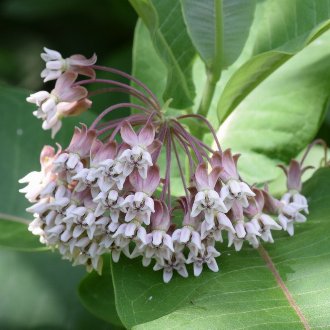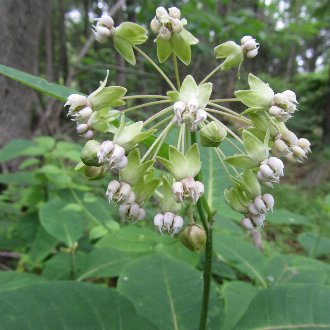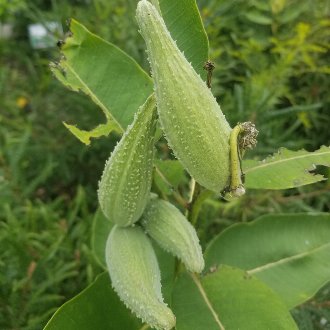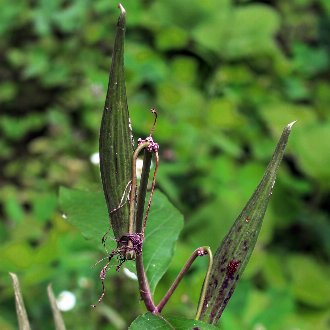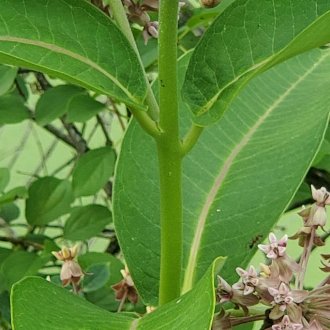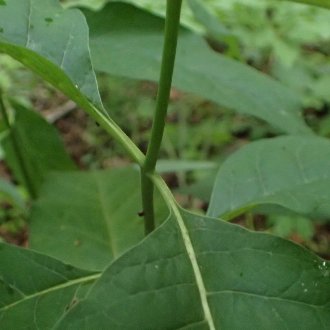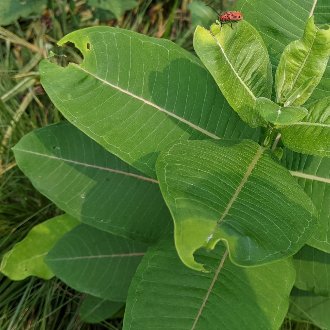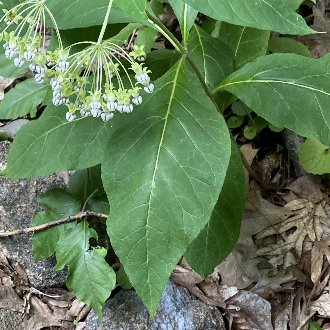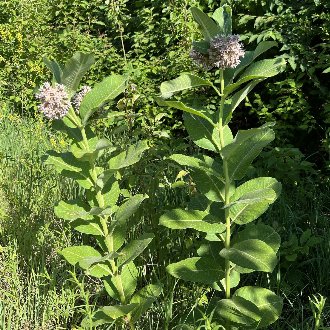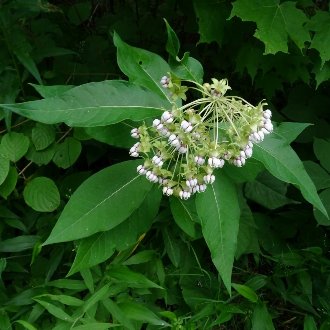Common Milkweed vs Poke Milkweed
These two tall, broad-leaved milkweeds can be confused, but are usually easy to tell apart by leaves, seed pods, and flowers. Common milkweed ranges farther south, west, and north, and occurs in sunnier, more open habitats, whereas poke milkeweed is found in shadier habitats sheltered from wind. These species can hybridize, and hybrids have intermediate characteristics, so it may not be possible to identify all plants to species level.
Common Milkweed (Asclepias syriaca) | Poke Milkweed (Asclepias exaltata) |
A sun-loving rhizomatous perennial native to northeastern North America, best known for being a preferred host of the Monarch butterfly. | A perennial plant named for its superficial resemblance (including both of the leaves, and the tall height and robust growth habit of this plant) to pokeweed (Phytolacca americana), which is not closely related. |
Inflorescence is denser, with more, smaller flowers. Petals are a washed-out pink to purple color. Photo © , CC BY-SA 4.0. | Inflorescence is sparser, with fewer, larger flowers. Petals are often green, occasionally pale purple. Photo © aberkov, CC BY 4.0. |
Seedpods are stouter, covered in numerous soft prickles. Seedpods may have any orientation, upright, horizontal, or even downward. Photo © Jason E. Farabaugh, CC BY 4.0. | Seedpods are narrow ah covered in long, vertical ridges. Seedpods are usually held upright Photo © aarongunnar, CC BY 4.0. |
Stem and foliage are thicker and more robust. Photo © Alexandra Destria, CC BY 4.0. | Stem and foliage are thinner and more delicate. Photo © Evan M. Raskin, CC BY 4.0. |
Leaves are broad and ovate, usually with rounded tips and bases. Leaves have more numerous prominent side-veins. Photo © Chase G. Mayers, CC BY 4.0. | Leaves taper more both at tip and base, and have fewer prominent side-veins. Photo © Sandy Wolkenberg, CC BY 4.0. |
Found in more sunny, open habitats with significant direct sun and often exposed to wind. Photo © Gemma Wyatt & Sean Riha, CC BY 4.0. | Found in shadier habitats, often sheltered from wind. Photo © Julie Reid, CC BY 4.0. |
Additional Notes
The physical characteristics of these plants are adaptations to their respective habitats. The more robust stem of common milkweed allows it to stay upright in strong winds, and its tougher leaves are better at conserving water in sunny and windy conditions. With access to more sunlight, it also has more energy to invest both in its physical structure, and in growing more flowers and seeds. In a windy environment, it is less important that its seedpods are high up, which may be why its seedpods are more likely to droop.Poke milkweed on the other hand has access to less light but also has less need to conserve water, and thus is better served by its thinner foliage and stem, which cost less energy to manufacture but leave it more vulnerable to water loss and toppling in wind. In the lower-light environment, it has less energy to invest in flowering and seed production so it tends to produce fewer flowers and seeds. In a low-wind environment, the extra few inches of an upright seed pod also becomes more important for maximizing seed distribution. The greater taper at the base of each leaf serves to minimize the degree to which each leaf shades out the others. The pointier leaf tips are likely an adaptation to maximize the rate of water drainage off the leaf, which may be more of an issue for this species because of its thinner leaves. Other plants with broad, thin leaves that grow in similar habitats, such as the sugar maple (Acer saccharum), have the same adaptation.
References & External Resources
These short lists show only links helpful for ID. For a complete list of references and resources also covering other aspects of ecology, visit the links section of the full article on each plant, which is the first entry here.

